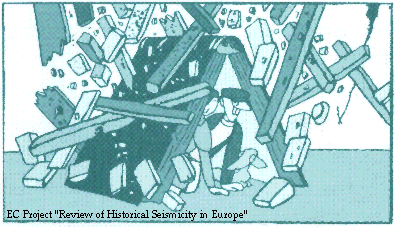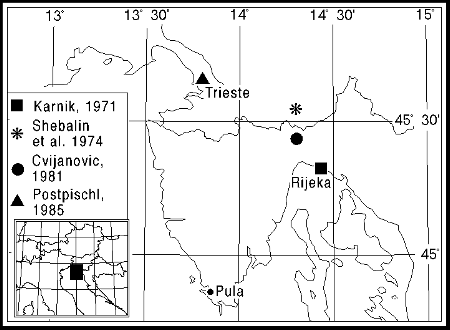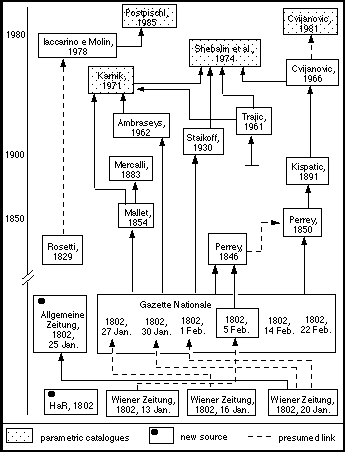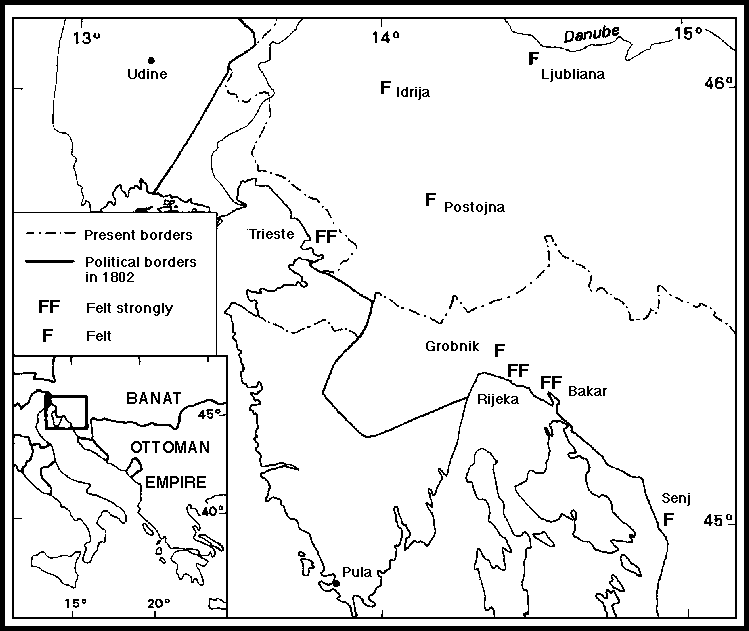
EC project "Review of Historical Seismicity
in Europe" (RHISE) 1989-1993

|
[Deliverables and queries] [Presentation] [Homepage] |
Introduction
Parametric catalogues locate the epicentre of
an earthquake occurred on January 4th, 1802 in various areas: in the wider
area around the towns of Rijeka, in Croatia (Karnik, 1971) or Trieste, in
Italy (Postpischl, 1985); in southern Slovenia near to the Croatian border
(Shebalin et al., 1974) or in the eastern part of Istrian peninsula (Cvijanovic,
1981) (Fig. 1). The parameters assigned to this earthquake by these catalogues
are shown in Tab. 1.

|
|
|
|
Lat Lon |
|
| Karnik, 1971 |
1802 01 04 |
07/08 |
45 18 14 24 |
>=7 MSK |
| Shebalin et al., 1974 |
1802 01 03 |
06 30 |
45 36 14 18 |
8 (?) MSK |
| Cvijanovic, 1981 |
1802 01 03 |
06 30 |
45 24 14 18 |
8 MSK |
| Postpischl, 1985 |
1802 01 04 |
06 00 |
45 40 13 48 |
5 MCS |
Parametric catalogues disagree also upon date
and time of the earthquake - Shebalin et al. (1974) and Cvijanovic (1981)
date the event on January 3rd - and about epicentral intensity, which ranges
from V MCS to VIII MSK. The earthquake catalogue of Slovenia (Ribaric, 1982)
does not include this event.
The background of parametric catalogues
To evaluate which records best represent the
earthquake effects, the first step was to go back to the sources from where
catalogues took the information. A supplementary analysis was devoted to
the most important seismological compilations referring to the involved areas.
Among them, the following do not mention this earthquake: Baratta (1901)
for Italy; Mitteis (1862), Müllner (1895) and Koblar (1896) for
Slovenia.
Fig. 2 presents the background of the parametric
catalogues and two sources unknown to the compilers of the catalogues, retrieved
through the investigation described further. From this figure, it clearly
appears that, apart from the observation made at Trieste (Rosetti, 1829),
the correspondences published in Gazette Nationale (1802a, b, c, d,
e, f) are the only contemporary records used by the compilers. The daily
Gazette Nationale - the same newspaper had also the title of Le
Moniteur Universal before and after the Napoleonic period - was printed
in Paris. The records concerning the earthquake were supplied by correspondents
from Vienna and Trieste.
Investigation
In the period when the earthquake occurred,
the area concerned was part of the Austro-Hungarian Monarchy, between two
French occupations of this region (1797 and 1805). Therefore, the possibility
of finding records from this area lies in research in central archives (Haus-,
Hof- und Staatsarchiv in Vienna for Trieste and surroundings, Slovenia and
Croatia) and local ones (such as those at Rijeka, Idrija, Ljubljana).
A sampling was carried out at the Historijski
arhiv Rijeka (Historical Archives of Rijeka, Croatia, from now on HaR) only.
In particular, the following documents were consulted: the Sjednice pulskog
kaptola (Sessions of the Capitol of Pula), available for the period 1801-1882
(HaR, 1801-1882); Knjiga upravljanja katedralne sakristije u Puli
(Book of the administration of the Cathedral sacristy in Pula), for the period
1741-1808 (HaR, 1741-1808).
The latter gives year accounts of income and
expenses, which were written once every year; some are very detailed, some
just brief with total sums. Neither type of documents contain information
on this earthquake.

In the fund storing documents produced by the
local government of Rijeka (Repertorio degli Atti esistenti nella Cancelleria
della Città di Fiume) a document written five days after the
earthquake by the local governor was found. It institutes religious
manifestations "against" the earthquake (HaR, 1802). The document is reproduced
in the Appendix.
A sampling was performed also in newspapers
in German language. Wiener Zeitung was a newspaper published twice
a week in Vienna since 1780. In its first part it had news from many European
countries (Italy, France, Switzerland, etc.). The news about the earthquake
were reported from Ljubljana, Trieste and Senj (Wiener Zeitung, 1802a, b,
c).
Allgemeine
Zeitung from Augsburg was a daily
newspaper which contains information about this event also (Allgemeine Zeitung,
1802). However, it cannot be considered as an independent source of information,
because it explicitly refer to the same Wiener Zeitung issues above
mentioned.
The analysis of 19th and 20th centuries historical
studies, such as Kandler (1855) for Trieste, Kobler (1896) and Klen (1988)
for Rijeka and Marochino (1978) for Bakar, did not supply information on
local contemporary sources of information on this earthquake, although they
give descriptions of other earthquakes (e.g. 1750).
Effect descriptions
Relying on the primary sources, the earthquake
effects can be described as follows (German texts are given in English
translation).
Rijeka, Bakar
A correspondence from Ljubljana, dated January
12th (Wiener Zeitung, 1802c), reports that on January 4th an earthquake
"between 7 and 8 in the morning had anxiously
worried our town and went without the misfortune. It was much stronger in
Fiume [Rijeka] and Bukkari
[Bakar] - stronger than ever in these localities - than here and has
threatened with horrible destruction. Strong shocks followed each other and
people were leaving their homes in fear not to be buried; also the strong
sea-waves broke through. Huge mass of water rose two feet above the shore
and threatened to fall down hanging like a wall. Desperate people were scared
of the inevitable breakthroughs of the furious sea, inundation of the area
and the destruction of the vineyards, fields and homes. The fear and despair
of the inhabitants of the towns near the sea can be only felt, and not described.
... This shaking had a direction almost from south to north, only some directions
towards west were deviating, and lasted particularly on the sea coast more
than a minute".
Dated January 22, a correspondence from Vienna
is published in the Gazette Nationale (1802d); it says that
"On a ressenti ... particulièrement
à Fiume [Rijeka] et Bukkari
[Bakar] des secousses violentes de tremblement de terre, qui
menaçaient de la ruine la plus effrayante".
The details are similar to those reported by
Wiener Zeitung. The perception of the earthquake in Rijeka and Bakar
is mentioned also in a following issue (Gazette Nationale, 1802e).
The document by the governor of Rijeka (HaR,
1802) does not supply any information on earthquake effects or on eventual
damage, but it may be considered as an effect by itself. Moreover, it does
not even give the information whether the earthquake was felt or not.
Grobnik, Senj
The newspaper Wiener Zeitung (1802c)
supplies the following description:
"Zengg
[Senj], January 5. Also the Theodor
Batthyanisch's graeflich Herrschaft Grobnigg [Grobnik] suffered from
an earthquake and heavy fall of rain. Almost all vineyards on the hills were
broken and fallen down and were covered by falling pieces of rocks; the one
in the lowland subsided and considerable hills arose instead of them. The
castle itself was, like many other houses, uncovered and only thanks to the
Providence there were no victims. Besides the earthquake and the inundation
we had also thunderstorm, while the lightning lit up the sheep pen and burned
it with 250 sheep. The peasant, owner of the sheep and pen, was brought into
a sad condition".
The Gazette Nationale (1802c) reports
the earthquake effects with similar wordings, but referring them to "la
seigneurie de Grobbing", which is an obvious missprint. It also adds
details to stress the bad sea conditions:
"Un capitaine du régiment d'Ottocha,
parti d'Aichellon sur la Licca, avec 12 hommes et 3 chevaux pour aller chercher
les fond à Agron fut renversé dans l'eau par un coup de vent,
avec tout ce qui se trouvait sur la barque. Il n'échappa que quelques
hommes, qui parvinrent à se sauver à la nage".
Idrija, Postojna, Duchy of Krain
The same correspondence from Ljubljana which
supplies information about the localities above mentioned (Wiener Zeitung,
1802c) gives also the following information:
"... Also the earth was shaken much more
terribly in Adelsberg [Postojna]
and in the mine town Idria [Idrija] ".
The Archives of Idrija mercury mine stores documents
about the mine from the year 1700. The diary of the mine was consulted, but
it contains no records about the event or eventual damage caused by it.
A correspondence from Vienna, dated 22 January,
reports that the earthquake was felt "dans le Duché de Krain"
(today central and southern part of Republic of Slovenia), without referring
the effects to any locality inside the territory of the Duchy at that time
(Gazette Nationale, 1802d). A reference to Idrija appears in a later issue
(Gazette Nationale, 1802e).
Ljubljana
The effects at Ljubljana are described in a
correspondence from the locality itself (Wiener Zeitung, 1802a):
"Yesterday
[January 4] in the morning between
7 and 8 we felt here one unimportant earthquake, whereupon lightning after
lightning, followed by thunderclaps illuminate our horizon. (It is strange
that out-of-town newspapers spoke earlier about an earthquake in Laybach,
where an inn should have been destroyed completely)".
The same correspondence was published also by
the Gazette Nationale (1802a). An ensuing issue of the Wiener
Zeitung (1802c) stresses that the shock was stronger at Rijeka and Bakar
than at Ljubljana.
Trieste
Both Wiener Zeitung (1802b) and Gazette
Nationale (1802b) publish the same correspondence, dated from Trieste,
January 16th:
"Après un vent impétueux qui
régna quelques jours, il commença le 3 au soir à pleuvoir,
la pluie, la grêle et la neige se succéderent tour à
tour jusqu'à minuit, vers 2 heurs, le tonnerre gronde d'une manière
effrayante. Cette tempête fut suivie d'un débordement de la
mer, chose dont on n'avait pas eu d'exemple depuis plusieurs années.
Une grande partie de la ville fut inondée, l'eau pénétra
dans les magasins situées au rez-de-chaussée et causa de grands
dommages. Cet orage se termina à sept heurs du matin, par une si violente
secousse de tremblement de terre qu'on ne se rappelle pas d'en avoir essayé
de semblable" (Gazette Nationale,
1802b).
A table of earthquake observations concerning
Trieste (Rosetti, 1829) confirms that the earthquake was strongly felt there,
although a description of the earthquake effects is not given. It also adds
an information about a light earthquake on the same day, at 4 in the
morning.
Banat and Turkey
One month after the earthquake, on February
7, a correspondence from Vienna reports that
"La secousse de tremblement de terre qu'on
a essuyée au commencement de janvier et sur tout cette côte,
s'est aussi fait sentir dans le Banat et en Turquie"
(Gazette Nationale, 1802f).
Banat is a region between Transylvania and rivers
Tisa and Danube, while the wording "Turquie" should be here interpreted as
referred to the Ottoman Empire, the western boundary of which at that time
corresponded roughly to the present north-western border of Bosnia and
Herzegovina.
It is worth noting that neither Wiener
Zeitung nor Allgemeine Zeitung have information about it, although
they had a regular correspondence from Belgrade and other towns in Turkey.
Conclusions
The material consulted allows to draw only few
conclusions regarding location and size of the earthquake. An earthquake
was felt on January 4th, 1802, between 7 and 8 in the morning (local time)
in a region between Trieste on the west, Ljubljana on the north and Senj
on the south.

Contemporary sources (Gazette Nationale, 1802a,
b, c, d, e, f; Wiener Zeitung, 1802a, b, c; HaR, 1802) suggest that at Rijeka,
Bakar, and Grobnik damage - if any - was light. Damage to buildings (Grobnik
castle, many houses and a sheep pen) is reported together with that caused
by the heavy winds and flood, so that it is difficult to separate the effects
due to each event.
Strong sea-waves for Rijeka and Bakar related
to the earthquake are reported by both Wiener Zeitung (1802c) and
Gazette Nationale (1802d); the latter is the same source quoted by
a study on seismic sea-waves in this area (Ambraseys, 1962). The correspondence
from Trieste (Gazette Nationale, 1802a) clearly states that the earthquake
occurred after a heavy storm, and after a "débordement" of
the sea, which happened around 2 in the morning, so that storm and high sea
did precede the earthquake. For the other localities it is not clear if the
sea-waves came before, during or after the earthquake. Therefore, it seems
that the high water and the damage caused by it are rather independent
coincidental events for other localities along the coast (Rijeka and Bakar)
too, where the storm, propagating from west towards east (which is usual
meteorological pattern in this region) came later.
The available data raises serious doubts on
the fact that effects were so heavy as the high epicentral intensities given
by Karnik (1971), Shebalin et al. (1974) and Cvijanovic (1981) suggest. The
parameters of Postpischl (1985) are obviously wrong. As no evidence supporting
such epicentral intensities and locations were found, it has to be supposed
that they come from unreported interpretation of the compilers.
Actually, the location proposed by Shebalin
et al. (1974) and Cvijanovic (1981) might follow from the knowledge of regional
seismicity and active faults: the high epicentral intensity would be then
necessary to justify the available data. But this, of course, is an hypothesis
only and, obviously, not a recommended procedure.
Finally, the information from the Gazette
Nationale (1802f) was used by A. Rethly (1952) to locate an earthquake
in Banat which, on the contrary, is not included in the more recent catalogue
of that area (Zsiros et al., 1988). At this stage of the research, the perception
of January 4th earthquake as far as Banat and Ottoman Empire territories
has yet to be confirmed, because the only available information is not
sufficiently reliable.
Acknowledgements
The authors would like to thank the historians
from the Archives in Rijeka, and especially to Boris Zakosek, for their kind
help in finding and explaining the contemporary material. Christa Hammerl,
Majda Hrzic and Renata Mukavec helped us with translations from German; Tibor
Zsiros from Hungarian.
Appendix
Historijski arhiv Rijeka, JU2, 163/1802.
"Ritrovandosi necessario di istituire delle
pubbliche preci, onde impetrare dall'Altissimo la serenità dell'aria
e la preservazione in conseguenza di questa città dal flagello del
Terremoto, fu di concerto colla superiorità ecclesiastica disposto
di tenere le medesime nel corso di due consecutivi giorni, cioè il
prossimo lunedì, martedì e mercoledì nella Chiesa di
S. Vito innanzi il miracoloso Crocefisso avanti e doppo mezzo giorno. Il
principio a questa divozione si darà il lunedì suddetto alle
ore 9 1/4 mediante una Processione, che sortirà dalla Collegiata.
Doppo mezzo giorno all'ore 4 verrà recitato il Rosario, colle Litanie,
e l'istesso verrà praticato nelle susseguenti due giornate ad esclusione
della Processione. Il primo giorno nell'ora soltanto conservata a siffatta
devozione dovranno esser chiuse tutte le botteghe. Tutti gli abitanti di
qualunque siasi rango, carattere, o condizione vengono di ciò mediante
il presente resi avvertiti, ed esortati contemporaneamente di concorrere
a questa divozione in unione col Magistrato.
Fiume, li 9 gennaio 1802
Ad Numero 163, Prot. pub. dd. 5 Februar.
1802".
English translation
"Since it seemed necessary to establish public
prayers, to ask the Almighty the serenity of the air and as a consequence
the preservation of this towns from the calamity of the earthquake, in agreement
with the higher-ranking ecclesiastics, it was decided to held the prayers
during two consecutive days, that are next Monday, Tuesday and Wednesday
in the Church of St. Vito, in front of the miraculous Crucifix before and
after midday. The beginning of this devotion will be on the said Monday at
9.15 with a Procession which will step out from the Collegiata (church).
After noon, at 4, the Rosary will be recited, together with Litanies, and
the same will be done in the two following days, with the exception of the
Procession. The first day only at the hour reserved for such devotion all
the shops must be closed. All inhabitants of whichever class, character or
condition have been advised of this by means of this proclamation and also
exhorted to participate in this devotion together with the Magistrato".
References
Allgemeine Zeitung, 1802. 25 January.
Ambraseys, N.N., 1962. Data for the investigation
of the seismic sea-waves in the Eastern Mediterranean. BSSA, 52:
895-913.
Baratta, M., 1901. I Terremoti d'Italia.
Saggio di Storia, Geografia e Bibliografia Sismica Italiana con 136
sismocartogrammi. Torino, 950 pp.
Cvijanovic, D., 1966. Jaci potresi (Io ³
VI MCS) u SR Hrvatskoj (Strong earthquakes (Io VI MCS) in Croatia). Geoloski
Vjesnik, 19, 139-167.
Cvijanovic, D., 1981. Seizmicnost podrucja
SR Hrvatske. Disertacija, Sveuciliste u Zagrebu, PMF, Zagreb.
Gazette Nationale, 1802a. 27 January.
Gazette Nationale, 1802b. 30 January.
Gazette Nationale, 1802c. 1 February.
Gazette Nationale, 1802d. 5 February.
Gazette Nationale, 1802e. 14 February.
Gazette Nationale, 1802f. 22 February.
HaR (Historijski arhiv Rijeka), 1802. JU2,
163/1802, 9 January.
HaR, 1801-1882. Sjednice pulskog
kaptola.
HaR, 1741-1808. Knjiga upravljanja katedralne
sakristije u Puli.
Iaccarino, E. e Molin, D., 1978. Raccolta
di notizie macrosismiche dellItalia nord-orientale dall'anno 0 all'aprile
1976. CNEN, RT/DISP(78)7, Roma, 65 pp.
Kandler, P., 1855. Indicazioni per riconoscere
le cose storiche del Litorale. Trieste.
Karnik, V., 1971. The Seismicity of the European
Area, 2. Dordrecht.
Kispatic, M., 1891. Potresi u Hrvatskoj.
Rad. jugosl. akademije znanosti i umjetnosti, CVIII, CIX, CXXII, Zagreb.
Klen, D. (Editor), 1988. Povijest Rijeke.
Rijeka.
Koblar, A., 1896. Zemeljski potresi na
Slovenskem. Kleinmayr in Bamberg, Laibach, 10 pp.
Kobler, G., 1896. Memorie per la storia della
liburnica città di Fiume. Fiume.
Mallet, R., 1854. Catalogue of recorded
Earthquakes from 1606 B.C. to A.D. 1850. 24th Report of the British Association
for the Advancement of Science, London, pp. 1-326.
Marochino, I., 1978. Grad Bakar kroz vjekove.
Gradski muzej, Bakar.
Mercalli, G., 1883. Vulcani e fenomeni vulcanici
in Italia. Milano.
Mitteis, H., 1862. Über Erderschutterungen
in Krain. Jahreshefte des Vereines des krainerischen Landesmuseums, III:
96-114.
Müllner, A., 1895. Das Erdbeben com
14. April 1895 ff. in Laibach. Argo, 7.
Perrey, A., 1846. Mémoire sur les
tremblements de terre dans le bassin du Danube. Annales des Science Physiques
et Naturelles, d'Agricolture et d'Industrie, Société Royale
d'Agricolture etc. de Lyon, IX: 333-414.
Perrey, A., 1850. Mémoires sur les
tremblements de terre ressentis dans la peninsule Turco-ellenique et en Syrie.
Mémoires couronnées et mémoires des savant etrangers,
Academie Royale des Sciences, des Lettres et des Beaux Arts de Belgique,
XXIII, Bruxelles.
Postpischl, D. (Editor), 1985. Catalogo dei
terremoti italiani dall'anno 1000 al 1980. Quad. Ric. Scient., 114, 2B,
Bologna.
Rethly, A., 1952. A Karpatmedencek Foldrengesei
(455-1918). Akademiai Kiado, Budapest, 510 pp.
Ribaric, V., 1982. Seismicity of Slovenia.
Catalogue of earthquakes (792 A.D.-1981). Ljubljana, 649 pp.
Rosetti, D. (Editor), 1829. Elementi per
la statistica di Trieste e dell'Istria. L'Archeografo Triestino, I, pp.
15-34.
Shebalin, N.V., Karnik, V. and Hadzievski,
D. (Editors), 1974. Catalogue of earthquakes of the Balkan region, I, UNDP-UNESCO
Survey of the seismicity of the Balkan region. Skopje, 600 pp.
Stajkoff, S.D., 1930. Matériel sur
la séismographie de la Bulgarie, la Thrace et la Macédonie.
Spis. na Blg. Ak. nauk. kn., XLII, Sofia.
Trajic, D., 1961. Les tremblements de terre
pour les années 361-1800 dans la Yougoslavie. ms.
Wiener Zeitung, 1802a. 13 January.
Wiener Zeitung, 1802b. 16 January.
Wiener Zeitung, 1802c. 20 January.
Zsiros, T., Monus, P. and Toth, L., 1988.
Hungarian earthquake catalog (456-1986). Budapest.
[Top]
[Vol.1]
[Vol.2]
[Deliverables and queries]
[Presentation]
[Homepage]